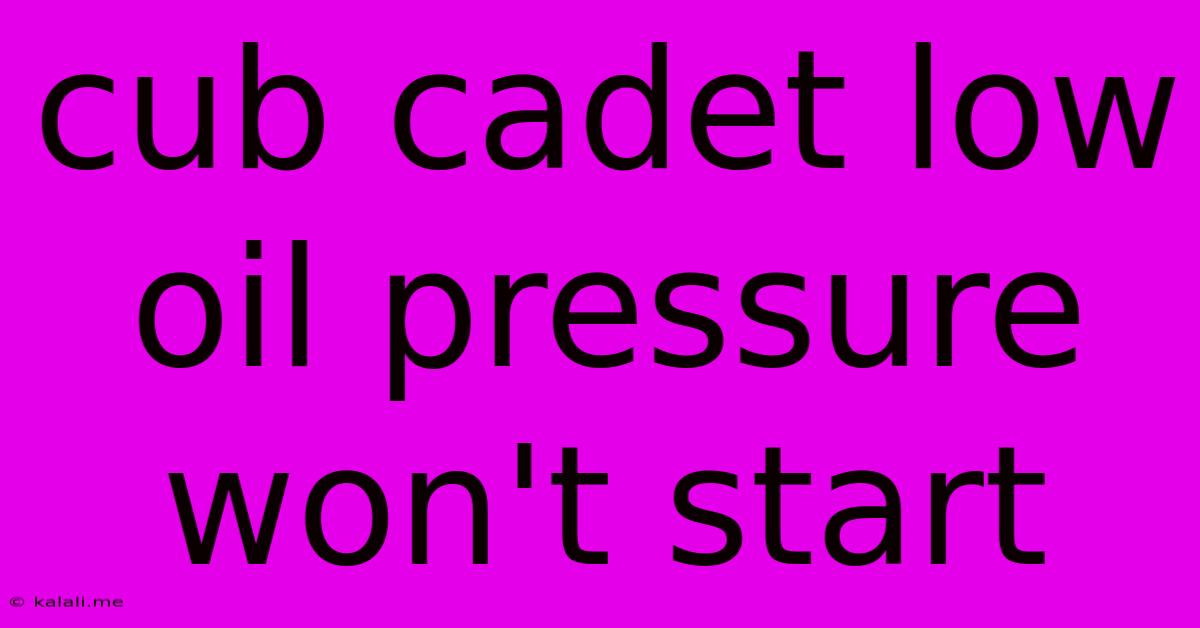Cub Cadet Low Oil Pressure Won't Start
Kalali
Jun 09, 2025 · 4 min read

Table of Contents
Cub Cadet Low Oil Pressure Won't Start: Troubleshooting and Solutions
Meta Description: Is your Cub Cadet refusing to start due to low oil pressure? This comprehensive guide explores common causes, troubleshooting steps, and solutions to get your mower running again. Learn how to check oil levels, diagnose sensor issues, and more.
Facing a frustrating "low oil pressure" issue with your Cub Cadet that's preventing it from starting? You're not alone. This problem, while potentially serious, can often be resolved with some careful troubleshooting. This guide will walk you through the most common causes and offer practical solutions to get your lawnmower back up and running.
Understanding the Low Oil Pressure Safety System
Many modern Cub Cadet models, and other lawn tractors, incorporate a safety system that prevents the engine from starting if the oil pressure is too low. This is a crucial safety feature designed to protect the engine from catastrophic damage caused by insufficient lubrication. When the oil pressure drops below a certain threshold, the system cuts off the power to the starter, preventing the engine from cranking.
Common Causes of Low Oil Pressure in Cub Cadet Mowers
Several factors can contribute to low oil pressure in your Cub Cadet, leading to the dreaded "won't start" situation. Let's explore some of the most frequent culprits:
-
Low Oil Level: This is the most obvious and easily resolved cause. Always check your oil level using the dipstick before attempting any other troubleshooting steps. Insufficient oil directly translates to low pressure. Refer to your owner's manual for the correct oil type and capacity for your specific Cub Cadet model.
-
Oil Pump Failure: The oil pump is responsible for circulating the oil throughout the engine. A faulty pump may not be able to generate sufficient pressure, leading to the low oil pressure shutdown. This requires replacement of the oil pump.
-
Clogged Oil Filter: A severely clogged oil filter restricts oil flow, reducing pressure. Regularly changing your oil filter (as recommended in your owner's manual) is crucial for engine health and prevents this issue.
-
Worn Engine Bearings: Over time, engine bearings can wear down, leading to increased clearances and reduced oil pressure. This is a more serious problem requiring professional repair or engine rebuild.
-
Oil Pressure Sensor Malfunction: The oil pressure sensor itself might be faulty, sending an incorrect low pressure signal even if the oil pressure is adequate. Replacing the sensor is often a relatively simple solution.
-
Leaking Oil: A significant oil leak can deplete the oil level quickly, resulting in low pressure. Check for leaks around the oil pan, filter, and other components.
Troubleshooting Steps: Diagnosing the Problem
Follow these steps to systematically troubleshoot the low oil pressure issue:
-
Check the Oil Level: This is the first and most important step. Add oil if necessary, following the manufacturer's recommendations.
-
Inspect the Oil: Check the oil's condition. Is it clean or dirty? Sludge or excessive contamination can indicate a larger problem.
-
Check the Oil Filter: Examine the oil filter for clogs or damage. Replace it if necessary.
-
Listen for Unusual Engine Noises: Unusual knocking or rattling sounds could indicate worn engine bearings.
-
Check for Oil Leaks: Carefully inspect the engine and surrounding areas for any signs of oil leaks.
Solutions and Repairs
The solution will depend on the identified cause:
-
Low Oil Level: Simply add the correct type and amount of oil.
-
Clogged Oil Filter: Replace the oil filter.
-
Oil Pump Failure: This requires replacing the oil pump, a task best left to a qualified mechanic.
-
Worn Engine Bearings: This usually necessitates a major engine repair or rebuild.
-
Oil Pressure Sensor Malfunction: Replacing the oil pressure sensor is usually a straightforward repair.
-
Oil Leaks: Repairing oil leaks may involve replacing gaskets, seals, or other components.
Preventing Future Low Oil Pressure Issues
Regular maintenance is key to preventing low oil pressure problems. This includes:
-
Regular Oil Changes: Follow the recommended oil change intervals specified in your owner's manual.
-
Oil Filter Replacement: Replace the oil filter with each oil change.
-
Regular Engine Inspections: Periodically inspect your engine for leaks, unusual noises, or other signs of wear.
By carefully following these troubleshooting steps and understanding the potential causes, you can effectively address the low oil pressure issue in your Cub Cadet and get your lawnmower back in working order. Remember that if you are not comfortable performing these repairs yourself, it's always best to consult a qualified small engine repair technician.
Latest Posts
Latest Posts
-
Aaobosi Portable Air Conditioner 10000 Window Locking System
Jun 09, 2025
-
12 Gauge Vs 14 Gauge Wire
Jun 09, 2025
-
Tribute To The World Tree Mtg
Jun 09, 2025
-
What Happens If You Mention Jury Nullification
Jun 09, 2025
-
How To Get Dry Paint Out Of Carpet
Jun 09, 2025
Related Post
Thank you for visiting our website which covers about Cub Cadet Low Oil Pressure Won't Start . We hope the information provided has been useful to you. Feel free to contact us if you have any questions or need further assistance. See you next time and don't miss to bookmark.